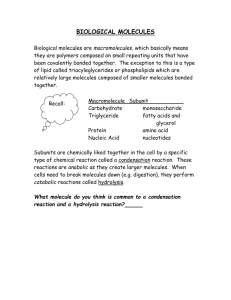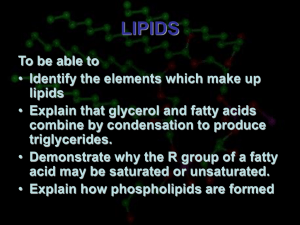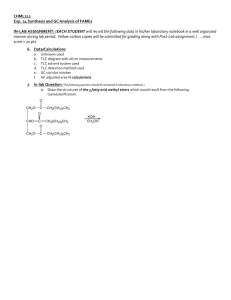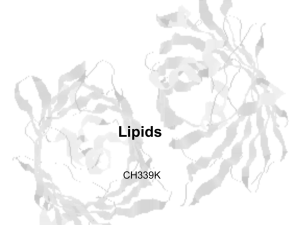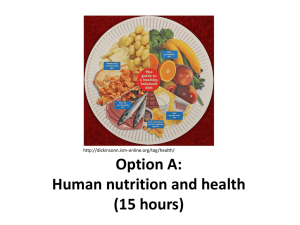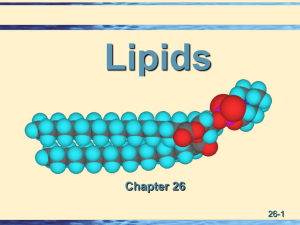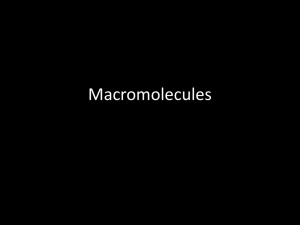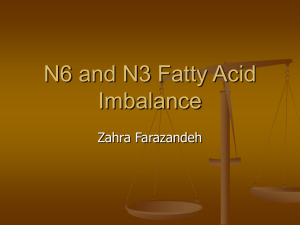Chapter 9 (part 1)
advertisement
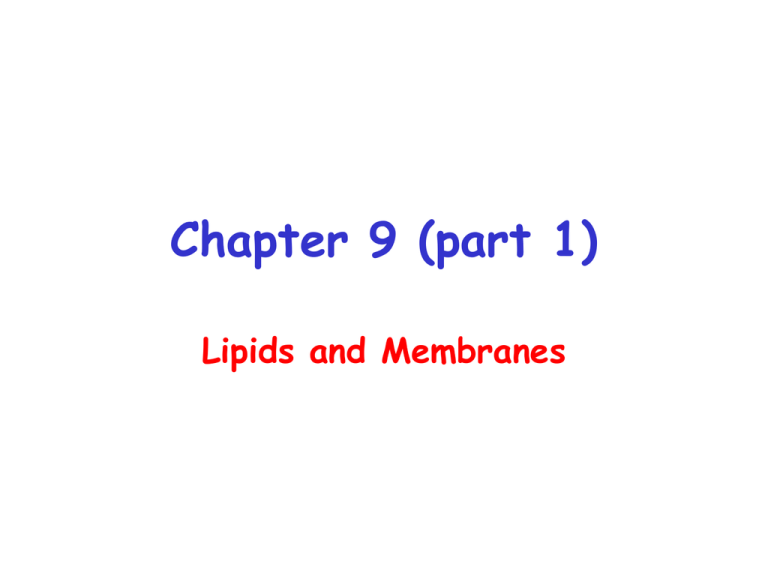
Chapter 9 (part 1) Lipids and Membranes Lipids • Lipids are compounds that are soluble in non-polar organic solvents, but insoluble in water. • Can be hydrophobic or amphipathic Major Lipid Classes • Acyl-lipids - contain fatty acid groups as main non-polar group • Isoprenoids – made up of 5 carbon isoprene units Lipid Subclasses Function of major acyllipids • • • • Phospholipids – membrane components Triacylglycerols – storage fats and oils Waxes – moisture barrier Eicosanoids – signaling molecules (prostaglandin) • Sphingomyelins – membrane component (impt. in mylein sheaths) • Glycospingolipids – cell recognition (ABO blood group antigen) Function of major isoprenoid lipids • • • • • Steroids (sterols) – membrane component, hormones Lipid Vitamins – Vitamin A, E, K Carotenoids - photosynthetic accessory pigments Chlorophyll – major light harvesting pigment Plastoquinone/ubiquinone – lipid soluble electron carriers • Essential oils – menthol Fatty acids • • • • • • • • Amphipathic molecule Polar carboxyl group Non-polar hydrocarbon tail Diverse structures (>100 different types) Differ in chain length Differ in degree of unsaturation Differ in the position of double bonds Can contain oxygenated groups Fatty acid nomenclature • Short hand nomenclature describes total number of carbons, number of double bonds and the position of the double bond(s) in the hydrocarbon tail. C18:1 D9 = oleic acid, 18 carbon fatty acid with a double bond positioned at the ninth carbon counting from and including the carboxyl carbon (between carbons 9 and 10) O C1 HO C6 C4 C2 C3 C5 C7 C9 C11 C13 C18 C16 C14 C12 C10 C8 C15 C17 Fatty acid nomenclature • Omega (w) notation – counts carbons from end of hydrocarbon chain. • Omega 3 fatty acids advertised as health promoting • Linoleate = 18:3 D9,12,15 and 18:3w3,6,9 O C1 HO C3 C8 C6 C4 C2 C5 C7 C9 C11 C13 C18 C16 C14 C12 C10 C H15 C17 Common saturated fatty acids common name IUPAC name melting point (Co) 12:0 laurate dodeconoate 44 14:0 myristate tetradeconoate 52 16:0 palmitate hexadeconoate 63 18:0 stearate octadeconoate 70 20:0 arachidate eicosanoate 75 22:0 behenate docosanoate 81 24:0 lignocerate tetracosanate 84 Common unsaturated fatty acids common name IUPAC name melting point (Co) 16:0 palmitate hexadeconoate 63 16:1 D9 palmitoleate cis-D9-hexadeconoate -0.5 18:0 stearate octadeconoate 70 18:1 D9 oleate cis-D9- octadeconoate 13 18:2 D9,12 linoleate cis-D9,12- octadeconoate -9 18:3 D9,12,15 linolenate cis-D9,12,15- octadeconoate -17 20:0 arachidate eicosanoate 75 20:4 D5,8,11,14 arachindonate cis- D5,8,11,14-eicosatetraenoate -49 Physical Properties of Fatty acids • Saturated chains pack tightly and form more rigid, organized aggregates • Unsaturated chains bend and pack in a less ordered way, with greater potential for motion 18:0 70o 18:1 13o 18:3 -17o Melting points of fatty acids affect properties of acyl-lipids • Membrane fluidity determined by temperature and the degree of fatty acid unsaturation of phospholipids • Certain bacteria can modulate fatty acid unsaturation in response to temperature • Difference between fats and oils • Cocoa butter – perfect melt in your mouth fat made of triacylglycerol with 18:0-18:1-18:0 fatty acids • Margarine is hydrogenated vegetable oil. Increase saturation of fatty acids. Introduces trans double bonds (thought to be harmful) Unusual fatty acids can function analogously to unsaturated fatty acids Major acyl-lipids •Phospholipids – membrane components •Triacylglycerols – storage fats and oils •Waxes – moisture barrier •Eicosanoids – signaling molecules (prostaglandin) •Sphingomyelins – membrane component (impt. in mylein sheaths) •Glycospingolipids – cell recognition (ABO blood group antigen) Phospholipids • Phospholipids are built on glycerol back bone. • Two fatty acid groups are attached through ester linkages to carbons one and two of glycerol. • Unsaturated fatty acid often attached to carbon 2 • A phosphate group is attached to carbon three • A polar head group is attached to the phosphate (designated as X in figure) Common membrane phospholipids CH3 O O H2C O O C C R1 R2 Phophtidate N NH3 CH2 CH2 H CH2 CH2 CH2 O O O O P O O CH2 O P O O O H2C H C O O C C R1 R2 CH2 O Phophatidylethanolamine P O H2C H C O O C C O O R1 R2 Phophatidylserine P O CH2 O CH3 CH2 COO O O O H C H3C NH3 O H2C H C O O C C R1 R2 CH2 O Phophatidylcholine O Enzymes used to Dissect Phospholipid Structure X O phospholipase D O P O phospholipase C O H2C H C O O CH2 phospholipase A1 phospholipase A2 O C C R1 R2 O
